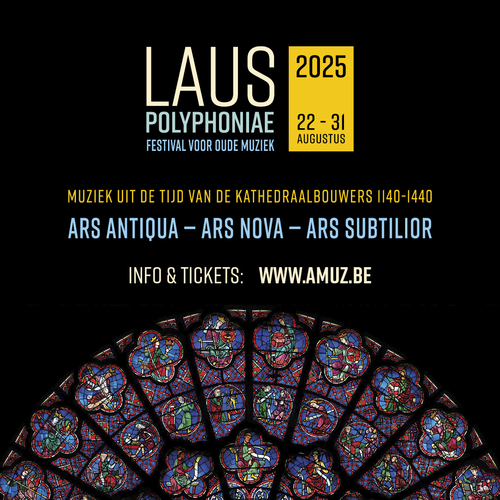Laus Polyphoniae 2025
Laus Polyphoniae 2025
Ars Antiqua – Ars Nova – Ars Subtilior, Polyphony from the Age of Cathedral Builders (1140–1440)On 15 April 2019, the unimaginable happened: Notre-Dame de Paris went up in flames. In a single moment, the cathedral that had welcomed believers and visitors from across the globe for centuries lost both its historic silhouette and its future. But it did not fall. What followed was a restoration campaign of unprecedented scale, culminating in its triumphant reopening on 7 December 2024 – just in time to mark its 800th anniversary.This is the ideal moment to delve into the marvel of medieval cathedrals: architectural masterpieces that, from the 12th century onwards, not only transformed spiritual practice but also ignited a revolution in music. Laus Polyphoniae 2025 tells the story of the cathedral builders – of towering spires that reshaped the skyline of Europe, of gravity-defying arches and luminous stained-glass windows. But cathedrals were more than just marvels to behold: they were musical laboratories, where composers and singers pushed the boundaries of what music could be.This year’s festival presents music as rich and varied as the architecture that inspired it. We travel through France, the Low Countries, England, Spain and Italy, exploring three distinctive styles of medieval music: the ‘old art’ of ars antiqua, with its quest for rhythmic innovation; the more elaborate and expressive ars nova; and the refined intricacies of ars subtilior, where poetry and music meet in exquisite union. We also cast our gaze beyond cathedral walls – to city squares, noble courts and bustling streets, where troubadours and minnesingers gave voice to love, longing and joy.Laus Polyphoniae once again welcomes the finest Belgian and international ensembles to Antwerp. Huelgas Ensemble and graindelavoix explore the tension between ancient and modern polyphony; Alla Francesca Jeune Ensemble returns to the sound world of Notre-Dame’s early days; Hespèrion XXI dives into Marian devotion with the Llibre Vermell; and Gothic Voices offers music from English cathedrals. Mala Punica follows the footsteps of Liège-born composer Johannes Ciconia, while Ensemble Micrologus, Le Miroir de Musique, Ensemble Céladon and ApotropaïK bring to life the vibrant, amorous, and often surprising soundscape of the Middle Ages.Our concerts take place in exceptional venues across Antwerp: from AMUZ and iconic churches like St. Paul’s, St. Andrew’s and St. George’s, to hidden gems such as the Handelsbeurs and the Brabantse Olijfberg church. Music enters into dialogue with literature and the city’s immovable heritage, transforming Antwerp into a living, breathing musical canvas.Since its founding in 1994, Laus Polyphoniae has become the world’s largest festival dedicated to the European heritage of polyphony. Organised by AMUZ (Flanders Festival Antwerp), it is rooted in Historically Informed Performance (HIP) and closely connected to academic research. Alongside internationally renowned artists, the festival also supports emerging talent, for instance through the International Young Artist’s Presentation.Each summer, Laus Polyphoniae attracts over 10,000 visitors from Flanders, the Netherlands, France, Germany – and even from as far as Japan and the United States. Together, they witness a musical panorama unlike anything they’ve seen or heard before: a world where stones sing and music storms the gates of heaven.Welcome to Laus Polyphoniae 2025!
Practical info

Pricerange per day

Main target group

Directions & transport

Surroundings

Average attendence per day

Art disciplines

